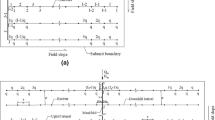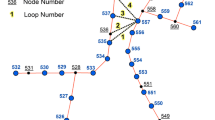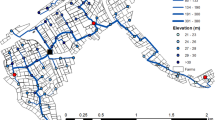Abstract
A microirrigation network system is composed of a subunit and main pipeline network. Previous optimization studies generally focused on manifolds or lateral pipes in subunits or main pipeline networks and did not consider systems as a whole; thus, a true optimum was difficult to achieve. In this paper, a microirrigation network system is optimized as a whole, and an innovative approach is proposed to optimize the subunit based on a maximum size objective. Based on four optimization models of a subunit for two optimization objectives and two layout modes, this paper discusses the optimum design criteria for a microirrigation network system by using the lowest annual total cost per unit area of the system as a measurement index. Mathematical optimization models of the subunit and main pipeline network were established and solved with a genetic algorithm. The subunit was treated as a whole to avoid an artificial distribution for the allowable pressure difference between the laterals and manifold in the subunit. The Clément methodology was used to determine the flow rates of pipelines in the peak period of irrigation. The results indicated that the annual total cost per unit area of the microirrigation network system obtained based on the optimization results of subunit model SWPL-A was the lowest considering various parameters. The annual total cost per unit area of the microirrigation network system obtained based on the optimization results of the SWPL-A subunit model was 0.79–14.90%, 0.94–3.01% and 0.28–5.20% lower than the costs obtained based on the optimization results of the SWUL-F, SWPL-F and SWUL-A subunit models, respectively. The results of this paper have some practical significance for the optimization of on-demand pressurized microirrigation network systems and regional pipeline networks.






Similar content being viewed by others
References
Abbasi H, Afshar A, Jalali MR (2007) Ant-colony-based simulation-optimization modeling for the design of a forced water pipeline system considering the effects of dynamic pressures. J Hydroinform 12(2):212–224
Alandi PP, Martin-Benito JMT, Alvarez JFO, Martinez MIC (2001) Design of water distribution networks for on-demand irrigation. Irrig Sci 20(4):189–201
Alandi PP, Alvarez JFO, Martin-Benito JMT (2007) Optimization of irrigation water distribution networks, layout included. Agric Water Manag 88(1–3):110–118
Baiamonte G, Provenzano G, Rallo G (2015) Analytical approach determining the optimal length of paired drip laterals in uniformly sloped fields. J Irrig Drain Eng 141(1):04014042
Bhave PR, Sonak VV (2005) A critical-study of the linear-programming gradient-method for optimal-design of water-supply networks. Water Resour Res 28(6):1577–1584
Bralts VF, Kelly SF, Shayya WH, Segerlind LJ (1993) Finite-element analysis of microirrigation hydraulics using a virtual emitter system. T ASABE 36(3):717–725
Carrion F, Montero J, Tarjuelo JM, Moreno MA (2014) Design of sprinkler irrigation subunit of minimum cost with proper operation. Application at Corn Crop in Spain. Water Resour Manag 28(14):5073–5089
Dercas N, Valiantzas JD (2012) Two explicit optimum design methods for a simple irrigation delivery system: Comparative application. Irrig Drain 61(1):10–19
GB/T 50485 – 2009 Technical Code for Microirrigation Networks
Gaur S, Dave A, Gupta A, Ohri A, Graillot D, Dwivedi SB (2018) Application of artificial neural networks for identifying optimal groundwater pumping and piping network layout. Water Resour Manag 32(15):5067–5079
Jiang ZQ, Ji CM, Qin H, Feng ZK (2018) Multi-stage Progressive Optimality Algorithm and its application in energy storage operation chart optimization of cascade reservoirs. Energy 148:309–323
Ju XL, Weckler PR, Wu PT, Zhu DL, Wang XK, Li Z (2015) New simplified approach for hydraulic design of micro-irrigation paired laterals. T ASABE 58(6):1521–1534
Keller J, Bliesner RD (1990). Sprinkle and trickle irrigation. New York: Van Nostrand Reinhold
Li RB, Jiang ZQ, Ji CM, Li AQ, Yu S (2018) An improved risk-benefit collaborative grey target decision model and its application in the decision making of load adjustment schemes. Energy 156:387–400
Masoumi M, Kashkooli BS, Monem MJ, Montaseri H (2016) Multi-objective optimal design of on- demand pressurized irrigation networks. Water Resour Manag 30(14):5051–5063
Moeini R, Afshar MH (2013) Constrained Ant Colony Optimisation Algorithm for the layout and size optimisation of sanitary sewer networks. Urban Water J 10(3):154–173
Monserrat J, Barragan J, Cots L (2018) Design of Paired Laterals on Uniformly Sloping Fields. J Irrig Drain Eng 144(6):04018008
Montalvo I, Izquierdo J, Perez R, Iglesias PL (2008) A diversity-enriched variant of discrete PSO applied to the design of water distribution networks. Eng Optimiz 40(7):655–668
Perez R, Martinez F, Vela A (1993) Improved design of branched networks by using pressure-reducing valves. J Hydraul Eng 119(2):164–180
Shiono N, Suzuki H, Saruwatari Y (2019) A dynamic programming approach for the pipe network layout problem. Eur J Oper Res 277(1):52–61
Suribabu CR, Neelakantan TR (2007) Design of water distribution networks using particle swarm optimization. Urban Water J 3(2):111–120
Tu Q, Li H, Wang XK, Chen C (2015) Ant colony optimization for the design of small-scale irrigation systems. Water Resour Manag 29(7):2323–2339
Varma KVK, Narasimhan S, Bhallamudi SM (1997) Optimal design of water distribution systems using an NLP method. J Environ Eng 123(4):381–388
Wang J, Zhu DL, Zhang L, Ames DP (2015) Economic analysis approach for identifying optimal microirrigation uniformity. J Irrig Drain Eng 141(8):04015002
Wu PT, Zhu DL, Wang J (2010) Gravity-fed drip irrigation design procedure for a single-manifold subunit. Irrigation Sci 28(4):359–369
Zhang L, Wu PT, Zhu DL (2013) Hydraulic design procedure for drip irrigation submain unit based on relative flow difference. Irrigation Sci 31(5):1065–1073
Acknowledgements
This research is supported in part by the National Key R&D Program of China (2017YFC0504402), and the Special Fund for Agro-scientific Research in the Public Interest (201503105 and 201503125).
Author information
Authors and Affiliations
Corresponding author
Ethics declarations
Conflict of Interest
None.
Additional information
Publisher's Note
Springer Nature remains neutral with regard to jurisdictional claims in published maps and institutional affiliations.
Rights and permissions
About this article
Cite this article
Ma, P., Hu, Y., Liu, H. et al. The Optimum Design Criteria for On-demand Pressurized Microirrigation Network Systems: Optimizing Subunits with Paired Laterals based on the Maximum Size. Water Resour Manage 34, 3237–3255 (2020). https://doi.org/10.1007/s11269-020-02610-8
Received:
Accepted:
Published:
Issue Date:
DOI: https://doi.org/10.1007/s11269-020-02610-8




